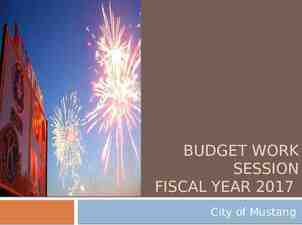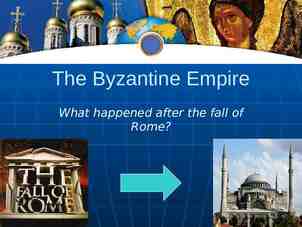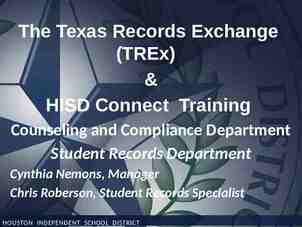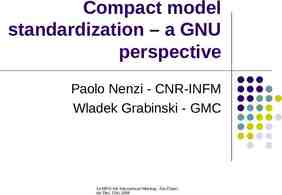PUBLIC CHARTER SCHOOLS July 14, 2022
22 Slides149.54 KB

PUBLIC CHARTER SCHOOLS July 14, 2022

WHAT LAWS CREATED PUBLIC CHARTERS IN WV? House Bill 206 from the 2019 1st Extraordinary Legislative Session created a brand-new Article (5G) within Chapter 18 of WV Code. Article 5G sets forth the following statutory topics for public charter schools: 1. Legislative intent; 2. Definitions; 3. Public charter criteria, governance structure, statutory compliance, etc.; 4. Powers and duties of the WV Board of Education; 5. Basis for funding, LEA status, authorizer oversight fee; 6. Authorizer powers and duties; 7. Public charter school governing board; 8. Application to establish public charter schools; 9. Charter contract requirements and terms of contracts; 2

WHAT LAWS CREATED PUBLIC CHARTERS IN WV? (Continued) 10.Charter contract renewal requirements; 11.Public charter school student enrollment, interscholastic sports, etc.; 12.Access to public facilities; 13.Appeal of authorizer’s decision to WV Board of Education; 14.Virtual public charter schools; 15.West Virginia Professional Charter School Board (HB 2012 - 2021 Legislative Session); and 16.Charter contract and enrollment application deadlines for schools opening in 2022 (HB 4019 - 2022 Legislative Session). 3

WHAT IS A CHARTER SCHOOL? Per NCES Fast Facts, “a public charter school is a publicly funded school that is typically governed by a group or organization under a legislative contract—a charter—with the state, district, or other entity. The charter exempts the school from certain state or local rules and regulations. In return for flexibility and autonomy, the charter school must meet the accountability standards outlined in its charter. A school’s charter is reviewed periodically by the entity that granted it and can be revoked if guidelines on curriculum and management are not followed or if the accountability standards are not met.” Per WV Code 18-5G-2(12), “public charter school means a public school or program within a public school that is authorized in accordance with the provisions of this article and meets the general criteria, governance structure and statutory compliance requirements described in 18-5G-3 of this code, and other provisions of this article.” 4

WHAT IS A CHARTER SCHOOL? (Continued) 18-5G-3(a) – Public charter schools authorized pursuant to this article shall meet the following general criteria: 1. Are part of the state’s system of public schools and are subject to general supervision by the West Virginia Board of Education for meeting student performance standards required of other public schools under 18-2E-5(d) and (e) of this code; 2. Are subject to the oversight of the school’s authorizer for operating in accordance with its approved charter contract and for meeting the terms and performance standards established in the charter contract; 3. Are not home school-based; 4. Are not affiliated with or espoused any specific religious denomination, organization, sect, or belief and do not promote or engage in any religious practices in their educational program, admissions, employment policies, or operations; 5

WHAT IS A CHARTER SCHOOL? (Continued) 5. Are not affiliated with any organized group whose espoused beliefs attack or malign an entire class of people, typically for immutable characteristics, as identified through listings of such groups as may be made by the U. S. Department of Justice, the Federal Bureau of Investigation, or officials having similar jurisdiction in this state; 6. Are public schools to which parents or legal guardians choose to send their child or children; 7. Do not charge tuition and may only charge such fees as may be imposed by noncharter public schools in this state; and 8. Have no requirements that would exclude any child from enrollment who would not be excluded at a noncharter public school. 6

WHAT IS A CHARTER SCHOOL? (Continued) 18-5G-1(c) – “All public charter schools established under this article are public schools and are part of the state’s public education system.” 18-5G-3(c) – “A public charter school authorized pursuant to this article is exempt from all statutes and rules applicable to a noncharter public school or board of education except for the following: 1. 2. 3. 4. 5. 6. Federal laws applicable to noncharter public schools; FOIA and open governmental proceedings rules; Immunization requirements; Compulsory school attendance requirements; Minimum number of days or equivalent amount of instructional time; Student assessment requirements, but only to the extent that will allow the state board to measure the performance of public charter school students; 7

WHAT IS A CHARTER SCHOOL? (Continued) 7. Student Data Accessibility, Transparency and Accountability Act; 8. Use of the electronic education information system established by WVDE for the purpose of reporting required information; 9. Reporting information on student and school performance to parents, policy-makers, and the general public in the same manner as noncharter public schools using the electronic format established by WVDE; 10.All applicable accounting and financial reporting requirements as prescribed for public schools, including adherence to GAAP, engaging an external auditor to perform an independent audit of the school’s finances, and submitting the audit to their authorizer and to the state superintendent of schools within 9 months of fiscal year end; 11.Criminal history background check; 12.Zoning rules for facilities; 13.Building codes, regulations and fees for facilities; and 14.Student transportation safety laws when transportation is provided. 8

WHAT IS A CHARTER SCHOOL? (Continued) Charter schools are organized by an “applicant” that submits an application to an “authorizer.” Per 18-5G-2(1), “applicant” means any one or more in combination of parents, community members, teachers, school administrators, or institutions of higher education in this state who are interested in organizing a public charter school and have obtained 501(c)(3) taxexempt status or have submitted an application for such status. Per 18-5G-2(2), “authorizer” means the entity empowered under this article to review applications, decide whether to approve or reject applications, enter into charter contracts with applicants, oversee public charter schools, and decide whether to renew or not renew charter contracts. 9

WHO CAN AUTHORIZE PUBLIC CHARTERS? 18-5G-2(2)(A) – A county school board when the charter school or application to form a charter school includes a primary recruitment area that is wholly within the county over which the board has jurisdiction. 18-5G-2(2)(B) – Two or more county school boards who must act together and function as a single authorizer in all respects under the law when the public charter school or application to form a public charter school includes a primary recruitment area that encompasses territory in the two or more counties over which the respective boards have jurisdiction: Provided that if such two or more school boards functioning together as authorizer reject the application, then one or more of the individual county boards may approve the application, but in such instance the charter school site must be located in one of the counties where the application was approved. 10

WHO CAN AUTHORIZE PUBLIC CHARTERS? (Continued) 18-5G-2(2)(C) – The West Virginia Professional Charter School Board created pursuant to 18-5G-15 of this code; or 18-5G-2(2)(D) – The West Virginia Board of Education in the following instances: The charter school or application to form a charter school or to renew a charter contract is in a county where the state board has intervened in the operation of the school system and limited the authority of the county board pursuant to 18-2E-5 of this code; and The application to form a public charter school or to renew a charter contract is approved by the affected county board or boards and is forwarded to the West Virginia Board of Education with a request that is perform to the authorizer function. 11

WHO HAS OVERSIGHT RESPONSIBILITY OVER AUTHORIZERS? Per 18-5G-4(b)(5), the West Virginia Board of Education is responsible for establishing “reporting requirements that enable the state board to monitor the performance and legal compliance of authorizers and public charter schools.” 18-5G-15(a) – “There is hereby created the West Virginia Professional Charter School Board which shall report directly to and be responsible to the state board, separate from the Department of Education, for carrying out its duties in accordance with this article.” 12

HOW ARE PUBLIC CHARTERS FUNDED? 18-5G-5 provides the overall requirements for funding of public charters. Per 18-5G-5(a), “the state board shall promulgate a rule pursuant to the provisions of 29A-3B-1 et seq. of this code setting forth requirements for public charter school funding. This rule shall include a requirement that 90 percent of the per pupil total basic foundation allowance follow the student to the public charter school, subject to the following: 1. The rule may provide for modification to the calculations set forth in 189A-7 of this code regarding the allowance for student transportation and in 18-9A-9(1) of this code regarding the allowance for current expense for the purpose of making appropriate adjustments to those allowances to account for student transportation and current expense related funding a school district loses in situations where it pays money to a public charter school pursuant to this subsection without a corresponding decrease in the county’s transportation and current expense related expenditures; 13

HOW ARE PUBLIC CHARTERS FUNDED? 2. The rule shall designate which school district is required to pay for a student attending a public charter school, and notwithstanding the terms in the definition of “net enrollment” in 18-9A-2 of this code, shall provide that the county school district paying for the student attending a public charter school have that student included in its net enrollment for purposes of 18-9A-1 et seq. of this code; and 3. The rule shall require the Department of Education to follow federal requirements in ensuring that federal funding follows the student to the public charter school. Per 18-5G-5(e), the state board shall promulgate a rule in accordance with 29A-3B-1 et seq. of this code to clarify, if necessary, the requirements of this article and address any unforeseen issues that might arise relating to the implementation of the requirements of this article: Provided, that nothing in this rule may conflict with this code. 14

WHAT PROMULGATED RULE? To address all the areas in which Article 5G required the state board to promulgate a rule, WVBE Policy 3300 was created. Sections 9 (Enrollment) and 12 (Finances), together, provide clarification for how public charter funding is calculated. 15

HOW ARE PUBLIC CHARTERS FUNDED? (Continued) Policy 3300, Section 12: Generally, 90% of Step 8 per pupil follows a student to their charter school. The amount owed by a county to a charter is withheld from the county’s net state aid and paid directly by WVDE to the charter. If a county has insufficient net state aid, the county must make a minimum of quarterly payments to the charters. In the initial year of existence for a charter, the charter will receive 90% of the per pupil basic foundation allowance for each student based on a projected enrollment count for the initial year as determined by the primary round of charter school enrollment (see section 9) Policy defines the primary round of enrollment as ending April 15th, however, HB 4019 in the 2022 Legislative Session, required a 30day extension of that cutoff date (only for schools opening in 202223 school year. 16

HOW ARE PUBLIC CHARTERS FUNDED? (Continued) Policy 3300, Section 12: Initial funding will be distributed to charters starting in July and in the same manner as county boards. However, distribution schedules will be adjusted after certified October enrollments are complete to allow for a true-up of funding to align with the actual number of students enrolled in the charters (as opposed to estimated enrollments based upon application data from the primary enrollment period). During the true-up, WVDE must determine the prior year county of residence for each charter student and whether the charter student was included in the county’s prior year net enrollment. If a student was not included in prior year county enrollment, 90% of the county’s local share follows the student to the charter (instead of Step 8) since no county is receiving net state aid for the student in 2022-23. 17

HOW ARE PUBLIC CHARTERS FUNDED? (Continued) Policy 3300, Section 12: In such situations, the local share per pupil is recalculated to include the student. Section 12.2.d.3 was written prior to the creation of the Professional Charter School Board and assumes a charter would be working closely with a county board in order to obtain authorizer approval. The creation of the Professional Charter School Board allows charters to be authorized with minimal communications between the charter and affected county boards of education. As a result, a county may actually have very little information for making appropriate personnel decisions in the spring leading up to the opening of a new charter. As WVDE becomes aware of new charter agreements, we will certainly work to share that information with the affected counties. Those agreements will include pertinent data for making personnel and other budgetary decisions when working on proposed budgets. Policy 3300 requires all charter students to be tracked by their home attendance area school based upon the student’s physical address. 18

HOW ARE PUBLIC CHARTERS FUNDED? (Continued) Policy 3300, Section 12: If a student moves to West Virginia and wants to enroll in a charter, they must first enroll in the noncharter public school within their home attendance area, then request a transfer to the charter. If a student changes physical address, it is the responsibility of the charter to report the move to the affected county boards of education. After the initial year of funding, the charter funding is based upon the charter’s prior year enrollment in the same manner as funding for noncharter public schools. Furthermore, after that initial year, county boards of education are not expected to provide funding to a charter school for students that were not previously enrolled with the county board of education. After the initial year of charter operations, the charter must conclude initial enrollment activities by February 15th. This provides more time for county boards of education to make financial and personnel decisions based upon projected charter enrollment. 19

HOW ARE PUBLIC CHARTERS FUNDED? (Continued) Policy 3300, Section 12: Per Section 12.2.f, charter schools are also eligible for increased enrollment funding. Section 12 provides more detail for how the transportation allowance will be modified when the charter does not provide transportation, or the county board of education agrees to provide transportation for the charter student. Section 12 also provides more detail for how the allowance for current expenses (Step 6a) is modified. Section 12 provides for 90% of counties’ PEIA and Retirement funding to also follow the student to the charter. As mentioned in the Federal Program and IDEA sessions, county federal allocations will also be adjusted once October enrollment is certified. However, in the case of Federal funds, the reduction is 100% per student (rather than 90% as is the case with State Aid). 20

ACCESS TO PUBLIC FACILITIES Per 18-5G-12: a) A public charter school may request usage of public facilities from the county board or other public entity in the county where the charter school is located or proposes to locate. A county board or other public entity shall make facilities available to the charter school that are either note used, in whole or in part, for classroom instruction at the time the charter school seeks to use or least the public facility. b) If a charter school seeks to lease the whole or part of a public facility, the cost of the lease must be at or under market value. c) During the term of the lease, the charter school is solely responsible for the direct expenses related to the public facility lease, including utilities, insurance, maintenance, repairs, and remodeling. The county school board is responsible for any debt incurred or liens that are attached to the school building before the charter school leases the public facility. 21

THANK YOU! Samuel E. Pauley, CPA School Operations Officer Office of School Operations and Finance 304-558-6300 [email protected] 22






